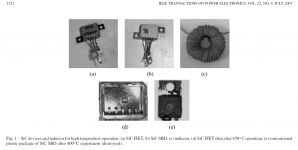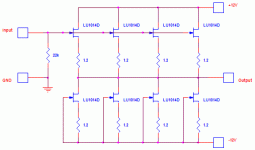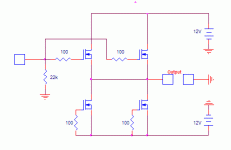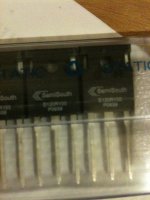It have been done beforeHey, since you're the "push 'em over the edge" expert here.
How would you go about soldering a device that gets so hot?
I did some playing around with pushing devices real hard, back then, the only solution I found, was to crimp instead of solder.
Magura
EDIT: And you might as well spill the beans. How do we get that plastic casing off, without damaging the fet?
Look at the attachment... please notice publicaton date
Take care
Attachments
Maybe the temp fluctuation could be handled, by adding some thermal mass?
Magura
Yes, I agree. I was working with bare die mounted to Kapton film only at the die pads. We would typically have several times the mass in copper soldered to the back of the die in a mounted leadframe situation.
BTW, die are typically soldered (Die Bonded) using a "silver solder" type paste that goes liquidous at about 450C.
Yes, I agree. I was working with bare die mounted to Kapton film only at the die pads. We would typically have several times the mass in copper soldered to the back of the die in a mounted leadframe situation.
BTW, die are typically soldered (Die Bonded) using a "silver solder" type paste that goes liquidous at about 450C.
Hmm, so the magic number is 175.
I see a cube filled with oil in my future
I have been working with high temp adhesives in another project recently, so bonding a JFET to a piece of carbon, and dumping it in such a cube, should be an interesting experiment.
Do you know if the phase change of the fluoinert is 100% reversible, or do I have to consider loss?
Magura
If by "100% reversible" you mean actuall loss of material? My set-up had a cooling unit that kept the fluid a 65C and a condesing coil setup at the top to cool and reclaim all the gasous vapor. The unit would typically be almost sealed but when we open the lid we would incure some loss. flourinert was $350-550 a gallon then (1994)
BTW, if you actually burn or epose florinert to flame it will produce a fatally poison gas


BTW, if you actually burn or epose florinert to flame it will produce a fatally poison gas
Hey, anyone got any ideas yet?
I have a dozen of these critters in the mail. I will probably try these with the BA-1 variant, it seems the most flexible.
Any advice on trying to match these things?
Plug them into a wall outlet and match by how much they dim the lights?
Hey, anyone got any ideas yet?
I have a dozen of these critters in the mail. I will probably try these with the BA-1 variant, it seems the most flexible.
Any advice on trying to match these things?
Did you get the 125 or the 120 variant ?
I have been told, that the 120 variant is within tighter tolerances withing each batch, thus easier to get good matches.
Magura
Hey, anyone got any ideas yet?
I have a dozen of these critters in the mail. I will probably try these with the BA-1 variant, it seems the most flexible.
Any advice on trying to match these things?
How about using them with a National LME49810, with the output devices configured as a triple to get round the lack of P channel devices, originally done on the Quad 303 if memory serves me correctly as bipolar PNP devices were expensive and prone to failure at the time.
arrival
Got a dozen of these in.
Did a quick test.
20V into 50ohms to drain, with gate shorted to train. No source resistor.
Here is what I got, Not the same VgS range I was getting with the IRF240's.
Math tells me I was putting a little over 300ma into it, and the HP supply looked about that way. But don't trust me here. At 20v, the HP can only do a half an amp. I have a larger HP amp that can do 48v and 10amps. But that was in the basement.
So with this model, a quick 5 second test (and they did not drift like IRF's do).
1. 1.114
2. 1.335
3. 1.335
4. 1.348
5. 1.350
6. 1.387
7. 1.383
8. 1.261
9. 1.275
10. 1.266
11. 1.264
12. 1.290
This looks promising, but surely is not an ideal matching scenario for these devices. I will look to juice it up this weekend. Looking for reasonable suggestions.
Got a dozen of these in.
Did a quick test.
20V into 50ohms to drain, with gate shorted to train. No source resistor.
Here is what I got, Not the same VgS range I was getting with the IRF240's.
Math tells me I was putting a little over 300ma into it, and the HP supply looked about that way. But don't trust me here. At 20v, the HP can only do a half an amp. I have a larger HP amp that can do 48v and 10amps. But that was in the basement.
So with this model, a quick 5 second test (and they did not drift like IRF's do).
1. 1.114
2. 1.335
3. 1.335
4. 1.348
5. 1.350
6. 1.387
7. 1.383
8. 1.261
9. 1.275
10. 1.266
11. 1.264
12. 1.290
This looks promising, but surely is not an ideal matching scenario for these devices. I will look to juice it up this weekend. Looking for reasonable suggestions.
Attachments
Well Guy's? I've put some thought into the Semisouth material I'm getting and I think the first project will be and AlephJ with JFET outputs!  Probably with a stock Aleph CCS. I built an Aleph 3 back around the Zen 4 days. Never got it going to the perfection it is known for. I think my Zen4 was better into the right speakers. I think this is a slam dunk though. By that I mean, If I get it right this time, it will be better than the A3 and I would be enjoying my classic for a long time...
Probably with a stock Aleph CCS. I built an Aleph 3 back around the Zen 4 days. Never got it going to the perfection it is known for. I think my Zen4 was better into the right speakers. I think this is a slam dunk though. By that I mean, If I get it right this time, it will be better than the A3 and I would be enjoying my classic for a long time...
I have another pair or so of these guy's and I'ld sure like to settle on a J2 type idea...
I'm sure everyone is what if'ing it to death??? What are you going to build???

I have another pair or so of these guy's and I'ld sure like to settle on a J2 type idea...
I'm sure everyone is what if'ing it to death??? What are you going to build???

I already built a channel of the Mini-A with The R100's.
I spent some time listening to it, it's flavor sorta reminded me of the FW J2 heard at BAF. It kind of had a 'darker' tone to it then default. It could be it was not optimized for the R100's at all, besides getting offset down. it could have been the feastrix FC at BAF with the darker tone there.
My next SemiSouth project will be Running two pairs a channel in a BA-1.
I have sent my Mini-A boards to Udailey to have another set of ears play with it.
I spent some time listening to it, it's flavor sorta reminded me of the FW J2 heard at BAF. It kind of had a 'darker' tone to it then default. It could be it was not optimized for the R100's at all, besides getting offset down. it could have been the feastrix FC at BAF with the darker tone there.
My next SemiSouth project will be Running two pairs a channel in a BA-1.
I have sent my Mini-A boards to Udailey to have another set of ears play with it.
The Vgs of the JFETs is lower than the Mosfets people have
been working with. This means running the npn governor
on the current source closer to saturation, which is why
I use a mu follower, and also lower resistance coming off the
input devices, which is why I parallel them.

been working with. This means running the npn governor
on the current source closer to saturation, which is why
I use a mu follower, and also lower resistance coming off the
input devices, which is why I parallel them.
- Status
- This old topic is closed. If you want to reopen this topic, contact a moderator using the "Report Post" button.
- Home
- Amplifiers
- Pass Labs
- Semisouth JFET's: What are they good for?



